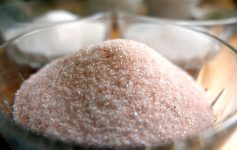
Learn How to Breathe Easier and Start Using the Language of Health to Thrive in a World of Chemical Goop.
(Click here for Part II when you’re through and/or to access both parts in a 13-minute audio.)
There’s been a lot of focus on the negative effects of unavoidable toxic exposures in in our world, including by yours truly. Does it ever make you feel like you are starring in a modern-day horror film surrounded by a cast of stealth, harmful, scary chemicals? I can just hear the trailer intro now:
“They are lurking around every corner in our neighborhood and inside the crevices of our cabinets!
“They are even sprayed on the food we consume and lurk in the water we drink!
“You can’t escape them! They are taking over nationwide!
“In fact lead has been poisoning your friends in Flint, Michigan, creating an outrage from coverups and demand for better remediation. Maybe your town is next!”
“You may be running, but you can’t hide!”
AHHHHHH!
It’s enough to make anyone, including myself at times, want to run from the dreary reality. Some may even lock themselves and their loved ones up in the safety of their hypoallergenic, fragrance-free, filtered, non-toxic, essential oils diffusing haven! Still others may go into denial, not willing to face the fact that some of their favorite modern-day conveniences, personal care products, and cleaning supplies could actually be harming their body and negatively impacting the health of their family. Unfortunately denial doesn’t make reality go away. None of these are our best coping options.
You May “Go Outta Your Mind” to Deny The Effects of Not Taking Action
A few weeks ago, I posted on my experience at The Institute for Functional Medicine (IFM) 2017 Annual International Convention: “The Dynamic Brain.” The conference was focused around the concept of neuroplasticity, the brain’s capacity to recover from injury by “rewiring” its neural networks in response to environmental stimuli. I then followed up with a blog on specific factors that could be altered to spark brain recovery. As a quick review, and maybe a more understandable summary, these included:
- brain and environmental enrichment
- dietary manipulation
- exercise
- phytonutrients and supplements
- modulating inflammation
- functional neurology
- using the influence of our senses on our brain, including the influence of smell on the mind (with essential oils as a stimulus) and the power of music
- prenatal stress and perception shaping brain patterns
- love and connection
Wait…something is missing!?
Sometimes you overlook the most obvious!
Yup, it’s toxins!
In fact, some experts believe that this explosion of chemicals (of questionable safety) are one of the major factors behind the worlds’ declining health in general and the rise in prevalence of neurological diseases.
In fact, there’s even a test called “Toxic Effects”! (Pretty cool.) If you scroll through the little green boxes of “Toxicant Effects” in the superb clinical interpretive guide – https://www.gdx.net/core/interpretive-guides/Toxic-Effects-CORE-Interp-Guide.pdf, you will get an idea of the bodily and brain effects of common exposures.
This topic of toxic brain was covered in depth at the IFM conference with Dr. Pizzorno. Pizzorno believes the focus of studying the impact of chemical exposures should be more clinical, vs. general population harm. He seeks to understand and describe the true toxic- disease associations in our world. Pizzorno has developed a method to establish disease burden, moving beyond mechanisms and associations. Integrative Practitioner reported his methods as follows:
Public health officials created a formula to determine what percentage of disease is caused by certain factors. For example, Pizzorno used the formula to identify how many chronic diseases develop as a result of neurotoxin exposure. His team determined incidence of disease in the “unexposed” population, the threshold for increased disease risk, the percentage of the population above the threshold, the incidence of disease in those above threshold, and then calculated the percentage of disease.
Dr. Pizzorno specifically highlighted the relevance of these toxins impact on the brain and his impressive findings at the conference. The article in Integrative Practitioner continues:
Currently, Pizzorno’s team has reviewed 26 toxins and toxin classes—including lead, mercury, BPA, and OCPs—100s of chemicals and POPs in some classes, 18 cancers, and 24 chronic diseases. Diseases studies include:
- ADHD
- Alzheimer’s disease
- ALS
- Peripheral neuropathy
- Brain cancer
While the results are varied and complex, one sentiment is consistent across all toxins and diseases examined: toxin load more than doubles disease risk for exposed populations. This damage can manifest in oxidative stress, inappropriate microglial activation, and mitochondrial damage.
Huh?
In plain English, toxins cause cellular stress, neurological activation, and can damage our little energy powerhouses in our cells.
What are the mechanisms beyond how these toxins create such havoc in the body? Pizzorno states through the following ways:
They increase free radical production and replace structural minerals. They also poison enzyme systems, competing with nutritional cofactors for finding sites. In addition, toxins can damage DNA and cell membranes, lead to epigenetic dysmodulation, block insulin receptor sites, and imbalance hormones.
I know, I know, it’s overwhelming!!
There Are Solutions!
This is why I’ve chosen to write the story of empowerment and provide solutions, which include our beloved essential oils. In fact, I did a whole webinar on it with a cast of two of my fellow “chemical-yuck-slaying” warriors.
Now, click here to read more about children and toxins and to get more empowering solutions in Part II.
You can also access the 13-minute audio to both parts here.
Disclaimer: This information is applicable ONLY for therapeutic quality essential oils. This information DOES NOT apply to essential oils that have not been tested for purity and standardized constituents. There is no quality control in the United States, and oils labeled as “100% pure” need only to contain 5% of the actual oil. The rest of the bottle can be filled with fillers and sometimes toxic ingredients that can irritate the skin. The studies are not based solely on a specific brand of an essential oil, unless stated. Please read the full study for more information.
This material is for information purposes only and is not intended to diagnose, treat, or prescribe for any illness. You should check with your doctor regarding implementing any new strategies into your wellness regime. These statements have not been evaluated by the FDA. (Affiliation link.)




1 Comment